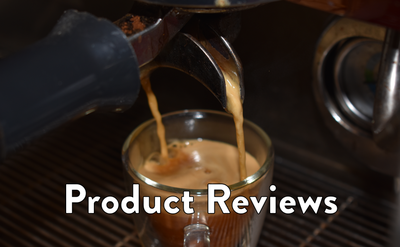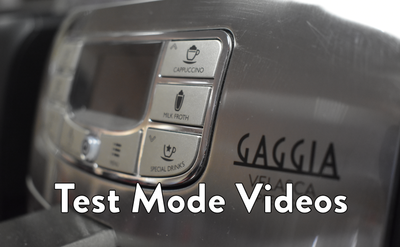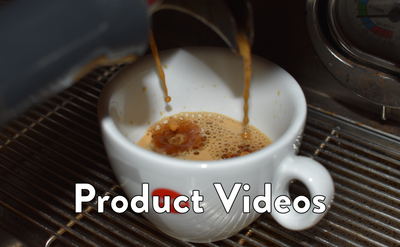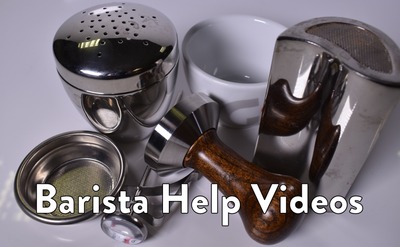Gaggia Home Barista Training Videos
Episode 1 - Coffee Types
Episode 2 - Making Black Coffees
Episode 3 - Milky Coffees
Episode 4 - Circus Drinks
Why train as a barista
The word barista is an Italian word, and it means "bartender". Our course is designed to give a basic idea and the skills needed to be a barista. It helps you to understand the various factors that go towards making a coffee, that delights you and the people who you serve the coffee to. The basic skills needed are the same for a professional barista who uses a professional coffee machine, or if you were making a coffee at home, with your home coffee machine.If you need barista training on a professional machine, we can arrange for this at the time of installation or at a time convenient to you. We can also provide training on professional machines for groups of 5 people. We mainly use a traditional and bean to cup home machine on the basic skills course.
Understand your coffee and chosen blend
Coffee as a beverage is prepared from the roasted seeds of a fruit from a coffee plant. The two most common sources of coffee beans are the highly regarded Coffea ARABICA, and the other called "ROBUSTA". The latter is more robust and can grow in more difficult conditions and has a more bitter taste. Coffee plants are cultivated in more than 70 countries, including Latin America, Southeast Asia, and Africa, typically 500 miles either side of the equator.Arabica coffees grow at a higher altitude - about 4000 feet above sea level. Robusta coffees grow at 1500 - 2000 feet above sea level. Once ripe, coffee "berries" are picked, processed and dried to yield the seeds inside. The seeds are then roasted to varying degrees, depending on the desired flavour, before being ground and brewed to create coffee.
Arabica Coffees can take a longer time to produce and generally are larger in size than the Robusta coffees. The taste of coffees are mainly due to chemical composition of the soil and can vary from place to place and also at different altitudes. Acidity, bitterness, earthiness, mint, Chocolate, fruity are some of the descriptions of the taste in coffee. Mixing and Blending different coffees from different plantations can achieve varying blends of coffee. As taste is subjective, it is difficult to say which is a better blend of coffee. Usually, Arabica coffees tend to be popular for people starting out in coffee, although it is only a guide.
Roasting the coffee changes the taste of the coffee by bringing out flavours and bitterness depending on the temperature and time the coffee is roasted.
Arabica Coffees can take a longer time to produce and generally are larger in size than the Robusta coffees. The taste of coffees are mainly due to chemical composition of the soil and can vary from place to place and also at different altitudes. Acidity, bitterness, earthiness, mint, Chocolate, fruity are some of the descriptions of the taste in coffee. Mixing and Blending different coffees from different plantations can achieve varying blends of coffee. As taste is subjective, it is difficult to say which is a better blend of coffee. Usually, Arabica coffees tend to be popular for people starting out in coffee, although it is only a guide.
Roasting the coffee changes the taste of the coffee by bringing out flavours and bitterness depending on the temperature and time the coffee is roasted.
understanding your coffee grinder
Once you have selected the blend of coffee beans, you have to grind the beans to the consistency required by the coffee machine you are going to use. Grinders can be either blade grinders or "burr" grinders. What you need for consistency and fineness is the "burr" grinder. The bigger the diameter the better it is. You can also have conical shaped burr grinders. Grind as you require the coffee, rather than grind too much. Even if you have a big hopper on your grinder, it is better to put little amount of beans as possible, unless you are going to make a lot of coffees quickly."On demand grinders" grind straight into your filter holder. You can also have electronic grinders for measuring accurate amounts of ground coffee.
Usually ground coffee has to be fine for espresso machines unless you have machines with crema devices that enhance crema, with pressure. You have to get the grind right by trying out the grind in your own machine. On a traditional basket/filter holder machine, the grind and the pressure you apply by tamping the coffee will determine the extraction time.
Usually ground coffee has to be fine for espresso machines unless you have machines with crema devices that enhance crema, with pressure. You have to get the grind right by trying out the grind in your own machine. On a traditional basket/filter holder machine, the grind and the pressure you apply by tamping the coffee will determine the extraction time.
understanding your coffee machine
Coffee Machines can be all types and sizes. A BARISTA may be required to use different types of machines and equipment to prepare coffee. Therefore it is essential to know the different equipment you may come across.
- Pump operated Espresso Machines
- Lever operated Espresso Machines
- Home machines of the above types
- Professional machines
- Filter machines
making and perfecting the extraction time
Perfecting the extraction on a manual filter holder machine can be different from machine to machine. Each machine can have pressure variations and temperature variations and brew head variations. Some machines operate with a solenoid valve, some with mechanical valves.The standard is one fluid ounce of coffee extracted in 20 seconds. There can be a tolerance of about 2 - 3 seconds. However, Italians usually extract two thirds of a fluid ounce in 20 seconds, what we call, a ristretto. If our extraction time is shorter it is called under extraction. If it is longer - over extraction. Having said this, you can extract to your own preference. Try a 1 fluid ounce 30 second extraction and see whether you like the taste. Normally extraction times are based on 7/8 gramme or 14/16 gramme shots. You can also increase your dosage within reason and get different results.
Extraction times on automatic machines can vary from machine to machine, depending on grinder settings, pre-infusion settings. Once set it will take a few shots for the machine to change to a different setting.
Extraction times on automatic machines can vary from machine to machine, depending on grinder settings, pre-infusion settings. Once set it will take a few shots for the machine to change to a different setting.
art of foaming and steaming milk
In the British Isles most coffees are consumed with milk. Although most of it is still consumed with a dash of milk, coffees with steamed and frothed milk are becoming increasingly popular. The content of milk in these Cappuccinos and Caffe Lattes are more than 60% of the fluid content of the drink. It is therefore important to get the milk prepared correctly. Dairy milk has about 3% protein content and 1.5-3 percent fat. The protein content is quite an important factor in frothing milk. When the milk is fresh, the protein content is at its highest. Once opened, and as it gets older, the content of protein will reduce. Make sure the milk is stored at the right temperature to get the best results. You can use full fat, semi skimmed or skimmed milk and long as they are fresh they will work well.Steaming or Frothing The way you heat the milk will depend on how you want the final texture. You can heat milk to be frothy, a non-frothy, non creamy milk, by varying the air you add to the milk. Heating milk is done by adding steam and air.
Steam On a domestic espresso machine, which has a boiler or thermo block, steam is produced by increasing the boiler temperature to the level required to produce steam. Steam can be released from the boiler by opening the steam release valve. Some machines have pulsing pumps to push little amounts of water and heat at the same time to produce steam. Opening the steam wand fully will give you the maximum amount of steam.
Air On all domestic Gaggia machines, the steam wands have a sleeve and there will be a hole or gap on the sleeve which allows air to go in. If you want to add air without using the sleeve then you have more control over the air that you want to add to the milk while steaming. If you want to micro foam your milk you will have to control the air and steam. Do not put too much air if you do not want too much froth.
Steam On a domestic espresso machine, which has a boiler or thermo block, steam is produced by increasing the boiler temperature to the level required to produce steam. Steam can be released from the boiler by opening the steam release valve. Some machines have pulsing pumps to push little amounts of water and heat at the same time to produce steam. Opening the steam wand fully will give you the maximum amount of steam.
Air On all domestic Gaggia machines, the steam wands have a sleeve and there will be a hole or gap on the sleeve which allows air to go in. If you want to add air without using the sleeve then you have more control over the air that you want to add to the milk while steaming. If you want to micro foam your milk you will have to control the air and steam. Do not put too much air if you do not want too much froth.
producing gourmet and speciality coffees
Americano : Espresso and hot water mixed equally, the term is thought to have come from WWII when American GI's were only familiar with drip coffee.
Black Eye : A cup of drip coffee with an added espresso shot, also known as depth charge, shot in the dark, red eye, hammerhead or slingblade.
Caffe Bonbon : A shot of espresso served in a small glass filled with condensed milk, these remain separate forming 2 layers.
Caffe Cubano : Made by adding sugar to the ground coffee before brewing.Cappuccino About 1/3 espresso 1/3 steamed milk and 1/3 froth. Often served with a dusting of cocoa powder.
Corretto : Espresso with some sort of liqueur added (Corretto is the Italian word for Spiked)
Doppio :Two shots of espresso in one cup
Espresso : A concentrated coffee beverage made by putting high pressure water (around 9 atmospheres) through fine ground coffee. The defining characteristics of espresso are a thicker consistency due to the higher amount of dissolved solids and a crema, a reddish brown foam on the surface. Espresso is chemically complex with around twice the caffeine content of regular coffee.
Flat White : About 1/3 espresso and 2/3 steamed milk, however the milk is prepared differently to a Latte with the volumised milk at the top folded into the lower layers leaving only a very thin layer of froth at the top.
Caffe Latte : About 1/3/ espresso and 2/3 steamed milk with a layer of foamed milk about 1cm thick on the top. A Caffe latte can be distinguished between a cappuccino and a flat white by the proportion of milk to froth.Latte macchiato Almost the reverse of a macchiato itself, this is foamed milk with just a little espresso in it.
Long Coffee : A double shot of espresso pulled into hot water. The order here is important the hot water goes in first or the crema is destroyed and may burn the espresso.
Lungo : About double the amount of water is used to brew the espresso yielding a higher volume but a weaker taste.Macchiato An Espresso with a tiny amount (about a teaspoon) of foamed milk.
Ristretto : Prepared with 0.75oz of water (rather than the 1 to 1.5 oz water for a regular Espresso). A true Ristretto will require adjustment to grinder settings to achieve the 20 to 25 second brew time to reach the proper result.
Short Black : A half sized Long Black, a single espresso pulled into a little hot water.
Black Eye : A cup of drip coffee with an added espresso shot, also known as depth charge, shot in the dark, red eye, hammerhead or slingblade.
Caffe Bonbon : A shot of espresso served in a small glass filled with condensed milk, these remain separate forming 2 layers.
Caffe Cubano : Made by adding sugar to the ground coffee before brewing.Cappuccino About 1/3 espresso 1/3 steamed milk and 1/3 froth. Often served with a dusting of cocoa powder.
Corretto : Espresso with some sort of liqueur added (Corretto is the Italian word for Spiked)
Doppio :Two shots of espresso in one cup
Espresso : A concentrated coffee beverage made by putting high pressure water (around 9 atmospheres) through fine ground coffee. The defining characteristics of espresso are a thicker consistency due to the higher amount of dissolved solids and a crema, a reddish brown foam on the surface. Espresso is chemically complex with around twice the caffeine content of regular coffee.
Flat White : About 1/3 espresso and 2/3 steamed milk, however the milk is prepared differently to a Latte with the volumised milk at the top folded into the lower layers leaving only a very thin layer of froth at the top.
Caffe Latte : About 1/3/ espresso and 2/3 steamed milk with a layer of foamed milk about 1cm thick on the top. A Caffe latte can be distinguished between a cappuccino and a flat white by the proportion of milk to froth.Latte macchiato Almost the reverse of a macchiato itself, this is foamed milk with just a little espresso in it.
Long Coffee : A double shot of espresso pulled into hot water. The order here is important the hot water goes in first or the crema is destroyed and may burn the espresso.
Lungo : About double the amount of water is used to brew the espresso yielding a higher volume but a weaker taste.Macchiato An Espresso with a tiny amount (about a teaspoon) of foamed milk.
Ristretto : Prepared with 0.75oz of water (rather than the 1 to 1.5 oz water for a regular Espresso). A true Ristretto will require adjustment to grinder settings to achieve the 20 to 25 second brew time to reach the proper result.
Short Black : A half sized Long Black, a single espresso pulled into a little hot water.
cleaning and maintaining your machine
The course also covers cleaning and maintenance of your coffee machine. We shall show you how you can get the best out of your machine and to extend the life of the machine.






